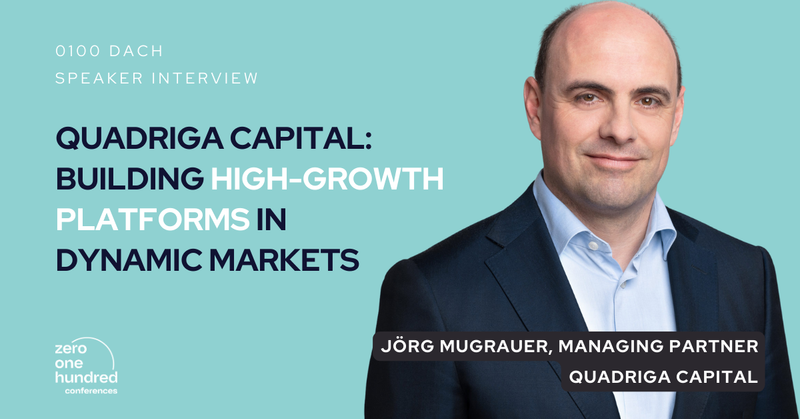Our latest speaker interview for the upcoming conference 0100 DACH features Jörg Mugrauer, Managing Partner at Quadriga Capital. In this insightful conversation, Jörg reflects on the unique challenges facing the DACH market and delves into thematically driven investment strategies. He emphasizes the necessity of constant adaptation in today’s dynamic environment and shares valuable insights on sustainability and exit markets, offering guidance for investors and industry professionals navigating an ever-evolving financial landscape.
Jörg will also be among the distinguished speakers in Vienna from February 18–20, 2025. He is set to participate in the panel “Future Perspective of DACH Private Equity” alongside industry leaders such as Roland Dennert from Cipio Partners, Andres Klab from Rivean Capital, and Marko Maschek from Marondo Capital.

DACH Region Focus: What unique challenges and opportunities do you see in the DACH region’s tech-enabled services, healthcare, and smart industries? How does Quadriga adapt its strategy to address these?
The DACH region presents a vibrant landscape with significant opportunities for growth and succession. However, companies in the region face critical challenges such as the transformative pressures of digitalization and AI, sustainability imperatives like the Green Deal, and a labour force constrained by demographic trends.
At Quadriga Capital, we decided ten years ago to adapt our strategy and tackle these challenges with a sector-focused and thematically driven asset selection strategy that aligns with enduring megatrends. Since 2015, we have distinguished ourselves as platform-company builders, crafting proprietary platforms with an emphasis on high growth, seamless integration, and economies of scale. Our bespoke succession solutions ensure continuity and long-term value creation, enabling us to effectively navigate the complexities of this dynamic region.
Sectoral Performance: Over the next few years, do you expect any of the three sectors Quadriga focuses on — tech-enabled services, healthcare, and smart industries — to outperform?
Our three focus sectors — tech-enabled services, healthcare, and smart industries — were selected for their thematic relevance and growth potential. Healthcare is particularly robust, supported by stable and growing demand. Through the deployment of digital and process-based USPs, we plan to expand further by building platforms in this sector.
In tech-enabled services and smart industries, we emphasize asset-light, digitalization-driven business models that leverage technological USPs for enhanced scalability and competitiveness. Artificial Intelligence becomes a scalable value driver for technology-enabled services platforms. While the smart industries sector has faced macroeconomic challenges in the DACH region over the past two years, early signs of recovery in 2025 position it as a promising vintage. This strategic alignment ensures our portfolio captures the growth potential across these sectors.
Macroeconomic Impact: How do inflation and macroeconomic uncertainty influence Quadriga’s approach to valuations, deal structures, and portfolio management?
Inflation and economic uncertainty have necessitated a more nuanced and risk-adjusted approach to valuations and deal structures. In our platform-building efforts, we integrate risk-adjusted multiples, reinvestment incentives, and earn-out mechanisms to mitigate market volatility while securing favorable terms.
To strengthen portfolio resilience, we maintain conservative debt levels, ensuring stability amid cash flow fluctuations. By prioritizing products and services with strong market fit and pursuing external growth through our platform concept, we aim to counterbalance uncertainties in organic growth and achieve sustainable scaling.
ESG Integration: Institutional investors are increasingly prioritizing ESG and sustainable returns. How does Quadriga embed these considerations into its investment strategy, particularly during the investment period?
Since 2010, ESG considerations have been integral to Quadriga Capital’s investment strategy. With initiatives such as QC-Sustain and adherence to the Operating Principles for Impact Management (OPIM), we have set industry benchmarks for sustainable practices. These principles guide asset selection and sourcing, embedding ESG throughout the investment lifecycle.
During the investment period, our QC-Sustain team tailors sustainability strategies for portfolio companies. Despite recent pushback against ESG topics in certain markets, especially the US, we believe our ESG and impact strategy delivers long-term value while meeting institutional investors’ growing demand for sustainable returns.
ESG in Growth-Stage Companies: How challenging is it to identify growth-stage companies with ESG strategies already embedded in their culture?
While ESG-focused growth-stage companies exist in the DACH region, identifying them remains a challenge due to the nascent adoption of impact-driven strategies. Exceptions are typically found among businesses with ESG-centric models, which serve as early adopters.
Quadriga Capital focuses on identifying these opportunities and fostering ESG integration where it is less mature. This not only enhances the investment appeal of such companies but also drives broader adoption of sustainability practices across the DACH region.
Liquidity and Exits: How does Quadriga balance providing liquidity solutions for early investors and preparing businesses for successful exits in a volatile market environment?
Navigating volatile markets requires a dual focus on stricter strategic positioning and customized exit processes. With ongoing geopolitical and economic uncertainties likely to persist through 2025, we remain committed to digital transformation and sustainable consolidation within our platforms. This ensures businesses are attractive to prospective buyers.
Transparent communication with potential buyers - both strategic and financial sponsors – in early phases forms the foundation of our approach. By tailoring exit processes to fit diverse strategic priorities, we aim to create various liquidity options with optimized outcomes for all stakeholders. In general, we believe, that the exit markets will improve in 2025 compared to 2023 and 2024.

